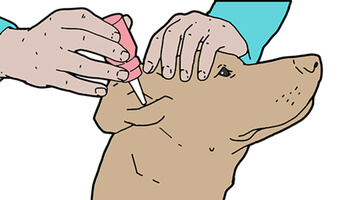How to tell if your dog is deaf
Quick Links
Is my dog deaf or just ignoring me?
It pays to observe their usual behaviour at home closely. If your dog has always appeared at the rattle of a full food bowl or barked their head off at a knock at the door but no longer responds to these triggers, it could be a sign of hearing loss. Similarly, if your dog has always greeted you when you get home but no longer appears on cue, it may be that they can no longer hear your car pulling into the driveway or your key in the lock. A deaf dog may also appear surprised if they’re touched while dozing, due to the shock of being stroked.
Upon hearing a noise, most animals will look up or around to find the source of the sound. You can test your dog’s hearing yourself by quietly entering the room that they’re in so that they don’t notice you, and then clapping your hands from a distance, to see if they react. This should be used as a test only, as approaching a deaf dog without warning can be startling for them. If your dog is only losing their hearing in one ear, you may find that they position themselves to listen to sounds with their good ear.
If you’re concerned your dog might not be able to hear you properly, it’s important that you take them to the vet for a check-up (even if they’re not so keen on the idea!). It could be that a temporary, treatable condition, such as a bad ear infection or excessive earwax, is causing the deafness; or your dog might have an underlying health problem that is affecting their hearing.
Causes of deafness in dogs
What breeds of dogs are prone to deafness?
What to do if your dog is deaf
Keep a deaf dog safe
Teach a deaf dog hand signals
Stay within sight
Get them an ‘I am deaf’ collar…
…Or a vibrating collar for deaf dogs
Another thing you could try is a vibrating collar for deaf dogs, which you can activate from a distance to get your dog’s attention when they’re not looking directly at you. A vibrating collar should be introduced gradually, and training a deaf dog to wear it should be a positive experience.
At first, simply play with your dog and hold the collar in your hand while it vibrates. Then gradually move the collar so that it vibrates against your dog’s leg or shoulder, before eventually working up to putting it around their neck. Every time you make the collar vibrate, give your dog a treat, and they should soon make the positive association and come back to you when you activate it – but if your dog remains uncomfortable with the collar after slow and patient introductions, this may not be the best solution for them.
Get your deaf dog a bell
Avoid startling a deaf dog
Dogs with hearing loss startle more easily, as they might not hear people or other animals approaching. This can be confusing and unnerving for your dog, and make them more likely to react defensively. Wherever possible, you should approach a deaf dog from the front, especially when they’re resting. If your dog is lying on the floor, they may feel the vibrations if you stamp your feet extra hard to announce your arrival. You could also switch the lights on and off a couple of times on entering a room, so that your deaf dog knows you’re coming.
If you’re concerned about your dog’s hearing loss, or any behavioural issues it causes, your vet or a certified behaviourist will be able to offer expert advice on keeping them happy and healthy.
Petplan is a trading name of Pet Plan Limited (Registered in England No. 1282939) and Allianz Insurance plc (Registered in England No. 84638), Registered office: 57 Ladymead, Guildford, Surrey GU1 1DB.
Pet Plan Limited is authorised and regulated by the Financial Conduct Authority. Financial Services Register No. 311969. Allianz Insurance plc is authorised by the Prudential Regulation Authority and regulated by the Financial Conduct Authority and the Prudential Regulation Authority. Financial Services Register No. 121849. Pet Plan Limited is a subsidiary of Allianz Insurance plc.









